Morocco Valleys
``Now and again it is necessary to seclude yourself among deep mountain and hidden valleys to restore your link to the source of life.``
The Valleys of Morocco are its lifeblood; fed by snowmelt and seasonal rainfall, they are the verdant oases where an exotic array of fruits, nuts, vegetables and flowers are cultivated. Alongside them the indigenous wild greens and forageables are encouraged to flourish.
From the Valley of the Roses and the Dades Valley on the south side of the High Atlas, the delicately scented Damascus Rose is grown and harvested for its exceptional oils and health giving properties. Figs are the next mainstay in the Dades Valley, grown against a backdrop of rose coloured crazy rock formations and ancient kasbahs, traditional rammed earth buildings and swaying poplars. In winter the trees are almost silver and create a stunning addition to the panoramic vista in the valley.
The remote mountain valleys of Imlil, Asni, Imenane, Ouaneskra and Azzadene in the High Atlas are where cherries, apples, walnuts and almonds are grown on terraced fields that cling to the mountainsides. In the lower valleys, grapes, pomegranates, plums and apricots along with lemons and oranges, give all year round fruits for local villagers to trade.
In the distant mighty Draa Valley, the extensive oasis of date palms produces some of the countries sweetest dates, harvest around October and November. There are many oases on the route to the Sahara, all cultivating delicious date crops. In the early spring many are processed into date syrup; an excellent natural alternative to sugar, this can be found in souks and small associations where women work exclusively to support their families.




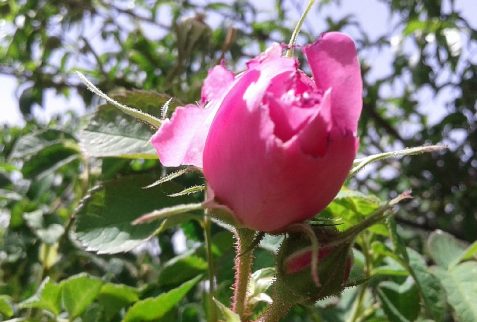
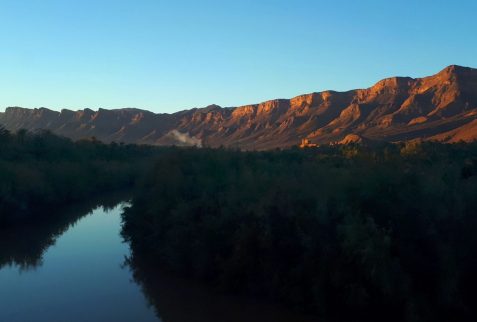



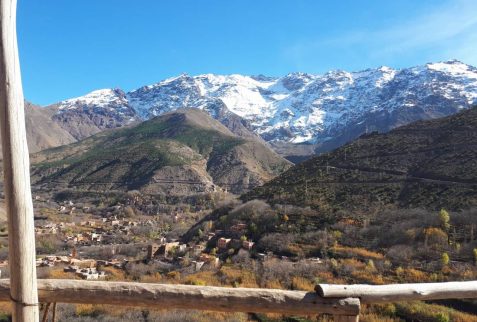


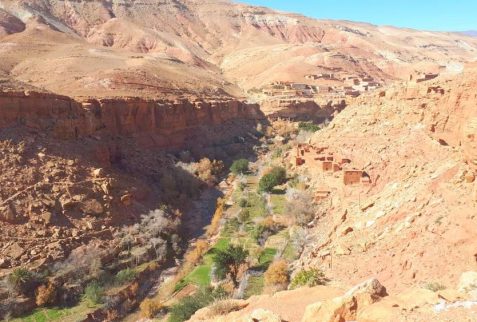

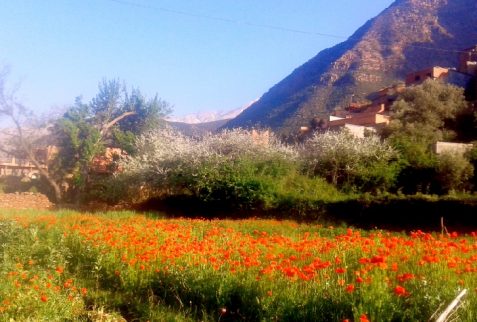



Just an hour’s drive from Marrakech brings you to the picturesque Ourika Valley, home to many Berber villages, artisans and farmers. This verdant lush valley is a fantastic place to visit for a day, enjoy a delicious tagine in one of the riverside restaurants with freshly squeezed juices, locally grown meat and vegetables, topped off with fruits from the nearby trees. Everything is fresh and seasonal. Continue down the valley to Setti Fatma where you can climb up to the waterfalls (suitable footwear recommended), ride fancy decorated horses or camels, browse in the riverside artisan shops and soak up the local hospitality.
If you are traveling from Marrakech over the High Atlas you have the option to take the Ounila Valley and travel into a remote region with traditional Berber Villages, ancient landscapes and lifestyles, kasbahs and palaces. On this route you will find Kasbah Telouet, once the home of the Pacha of Marrakech, its ruined outer walls hide a spectacular inner palace, well worth the visit. Further along the valley you will come to Ait Benhaddou, a fortress ksar perhaps better known for its use as a blockbuster filming location. The Gladiator, Prince of Persia and The Mummy are some you may know. This is also the caravan route to Timbuktu where salt was taken by camels; it is still mine there today and you can see the great salt pans in the village along the Ounila Valley.
If you are travelling from Fes to the Sahara Desert, it is likely you will pass the Ziz Valley, as it snakes its way down through the dramatic Ziz Gorges bringing life to the oases before disappearing into the distant dunes of Merzouga and Erg Chebbi. The Ziz River flows some 300 kilometres from its source in the Middle Atlas Mountains to the Sahara.
Paradise Valley is located approximately 20 km north of the southern Atlantic coastal resort town of Agadir. The valley is known for its abundance of rock pools and small waterfalls. In spring after seasonal rains it is quite spectacular and can be visited on a daytrip or better still, spend a few days exploring the area.
Ait Bougamez is known locally as The Happy Valley as the inhabitants have such a pleasant disposition. Located in the Central Atlas, it is a region popular for some of the best walking in Morocco. The M´Goun Valley is a remote area with long crested ridges and deep gorges, some very challenging trekking and used in the Ultra marathons run in the mountains of the Central and High Atlas.
With such diverse landscapes, Morocco is for all seasons and all types of travellers, it has so much to offer, so much to see, experience and discover, why not book your adventure and come and see for yourself.


